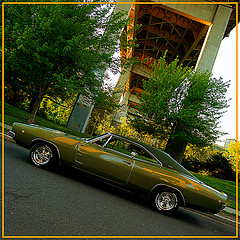Pundits have been predicting that 2008 won’t be kind to auto manufacturers. But a quick tour of the year’s first two major auto shows — the North American International Auto Show in Detroit and the Chicago Auto Show — demonstrates that manufacturers plan to do anything but pull in their horns. (And when it comes to Chrysler, we can say that quite literally, since its Detroit show press event featured a full-on cattle drive.)

http://flic.kr/p/fADHB8
The fact is, the NAIAS was one of the most diverse and absorbing in recent years, featuring a virtual potpourri of technology, designs and concepts that foretell very clearly that the future of the automobile will be interesting but the path to that future will be littered with failures and missteps as well as triumph. And Chicago added to the mix with important releases from Volkswagen, Chevrolet, and Dodge, among others. Perhaps the most heartening idea to emerge from the show was the realization that “environmentally conscious” doesn’t have to translate as “dull.”
Our roving reporter found that not only were the shows literally stuffed with various environmentally friendly vehicles — both concepts and production cars — but, interestingly, among the vehicles that could claim some kind of “green” label were several high-performance, enthusiast-vehicle offerings, something that was unprecedented. Among the vehicles were the highly touted Fisker Karma all-electric sports sedan, and cars from such mainstream makes as BMW, Audi and even Ferrari. BMW took the occasion to acquaint consumers with the idea that a twin-turbo diesel could more than adequately power “the ultimate driving machine,” while Audi took a similar effort to an even greater extreme with its Audi R8 V12 TDI turbo-diesel-powered sports car complete with an excessive 500 horsepower. Ferrari showed of an “experimental” F430 re-tuned to run on predominantly ethanol E85 and emblazoned it with “BioFuel” graphics.
Greening the USA
The U.S. manufacturers weren’t to be outclassed, either. For example, Saturn showed its Flextreme Plug-In Hybrid concept; Cadillac introduced its Provoq hydrogen fuel cell-powered crossover; Ford exhibited several vehicles with its coming ecoBoost direct fuel injection-turbocharging technology including the Ford Explorer America concept; and the Dodge ZEO took its very name from “zero-emissions.”
One of the concept cars we were most taken with was the very cool Chrysler ecoVoyager, a vehicle that proved the impossible — that a “one-box” van shape could be elegant. The four-door, four-passenger sedan offered arresting details like its short front overhang and boat tail rear. Equally avant-garde was its drive system with power supplied primarily from a lithium-ion battery pack capable of a 40-mile range from its 200-kilowatt (268-horsepower) electric motor. (After the juice in the battery is exhausted a hydrogen fuel cell kicks in to recharge it.) So on the concept front, at least, it seemed a “conventional” powertrain was a rarity while various alternative forms took center stage.
The debut vehicles in Chicago were not as abundant but equally impressive. Dodge showed off its Challenger SRT8, a throwback to the musclecar era that offers modern amenities like traction control and a navigation system unheard of in 1970 when the first Dodge Challenger rolled our way. Chevrolet showed off its Traverse crossover vehicle, joining the highly successful troika of Buick Enclave, GMC Acadia and Saturn Outlook. And Volkswagen burst through with its Routan minivan, a Chrysler minivan in a very convincing VW disguise. All in all it is obvious that the car companies will keep swinging, especially at green balls, whether the economy is vibrant or not.
—Driving Today Contributing Editor Tom Ripley writes about the auto industry and the human condition from his home in Villeperce, France. © Studio One Networks.
Tagged with: Chevrolet • Dodge • fuel savings • hybrid • Volkswagen
Filed under: Save Gas & Earth